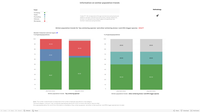
This dashboard provides information at the national level on winter population trends of bird species.

This dashboard provides information at the national level on breeding population and distribution trends of bird species. It also includes the master list of bird species reported by Member States.

This dashboard provides information on the number of bird species reported by each Member state.

This dashboard provides information on the numbers and surface area of Natura 2000 sites and associated legal measures in place per Member State as well as information on research on bird populations. For official count of number of sites and their areas and EU area statistic please refer to the Natura 2000 barometer.

The quietness suitability index (QSI) provides the overview with the highest (QSI=1) and lowest (QSI=0) proportion of potential quiet areas in Europe.

The map shows the quintiles of the geographical distribution of green patent families at country level.

The map shows the quintiles of the geographical distribution of green patent families at regional level

The chart shows the vegetation productivity changes (%) over areas with land use change in the period 2000-2018. The values are broken down by major land use change drivers.

Change of vegetation productivity during the years 2000-2016. Vegetation productivity was calculated for each 500m grid cell from a remote sensing derived vegetation index (PPI). The layer shows the changes expressed in % of 2000 calculated from the fitted line of the linear trend model.

The chart shows significant trends of vegetation productivity, expressed in % change. The % change values were derived from the fitted linear trend line.

The chart shows the effect of frost frequency variations on vegetation productivity, expressed in standard deviation units of vegetation productivity.

The chart shows the effect of temperature variations on vegetation productivity, expressed in standard deviation units of vegetation productivity.

The chart shows the effect of precipitation variations on vegetation productivity, expressed in standard deviation units of vegetation productivity.

Vegetation productivity indicates the spatial distribution and change of the vegetation cover - a key characteristic of ecosystem condition.
Vegetation productivity in Europe on average has a regional pattern of increase and decline. Increase was observed most in South Eastern Europe, over croplands and wetlands in the Steppic region and grasslands and sparsely vegetated lands and in the Black Sea and Anatolian regions. Decline happened most over croplands and grasslands in the Atlantic region as well as over wetlands in the Alpine region.
Climate has important influence on vegetation productivity in Europe. Strongest driver is precipitation, especially in the South Eastern regions. Decreasing number of frost days increased productivity in the Pannonian region but decreased productivity in the Atlantic region.
Climatic variations are important drivers of vegetation productivity, but land use changes are even stronger. Productivity was most increased by agricultural land management and converting other lands to agriculture, whereas largest decrease was caused by sprawling urban areas.

This viewer provides statistics on spatial extent and land use distribution of floodplain areas of Europe. Here, floodplains are defined as the flood prone area, i.e. the area that would be flooded during a 100-year flood, if there were no flood protection in place. Most flood prone areas are, however, protected against flooding. The statistics are presented in a series of dashboards providing an overview of floodplain characteristics, by country, by river basin districts, and in Natura 2000 sites. The statistics include the extent of floodplains, their ecosystem distribution based on MAES classification and the Copernicus Riparian Zone Products, as well as land cover flows between 2000 and 2018.

This figure shows connectivity of rivers in EEA-39 as defined in "Mapping the world’s free-flowing rivers" (https://www.nature.com/articles/s41586-019-1111-9). Dams and reservoirs and their up- and downstream propagation of fragmentation and flow regulation are the leading contributors to the loss of river connectivity.

The figure illustrates the estimated effects on national GHG emissions due to the increase in national renewable energy consumption since 2005